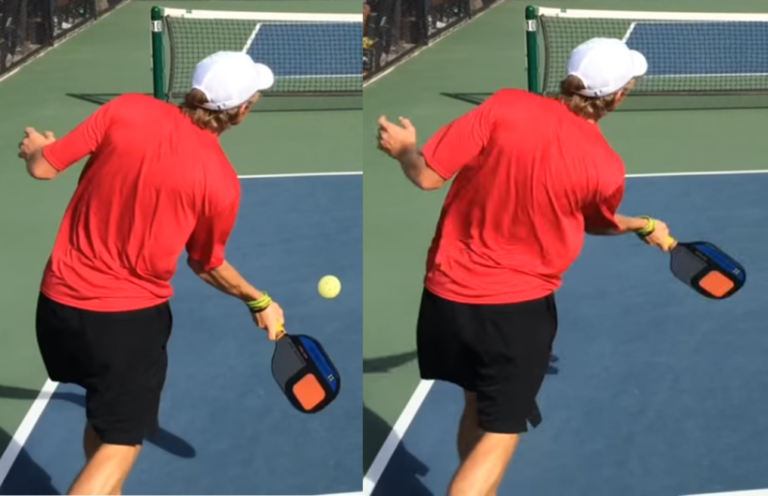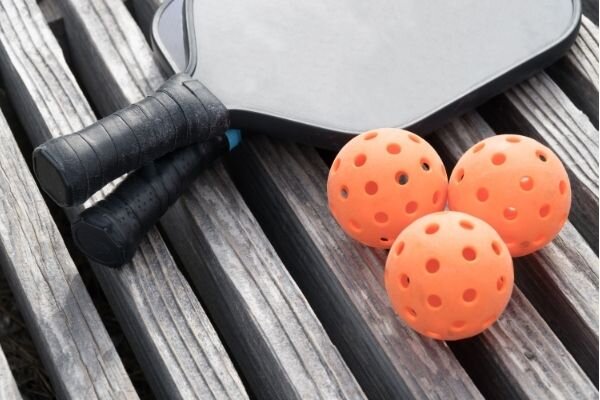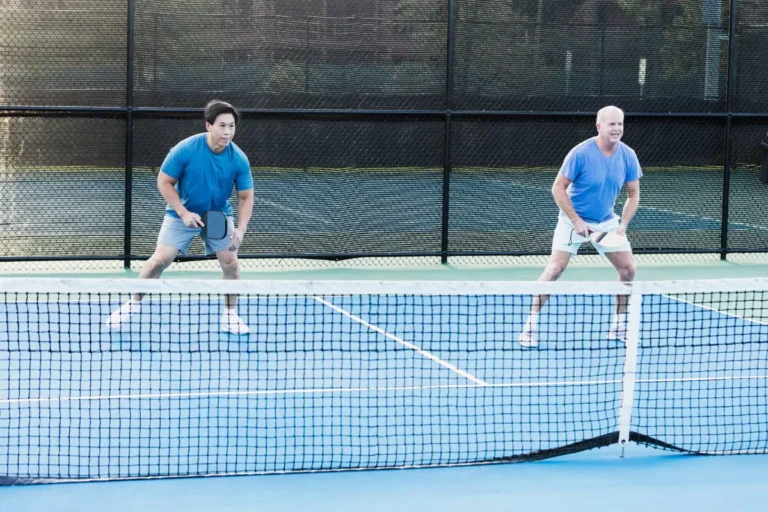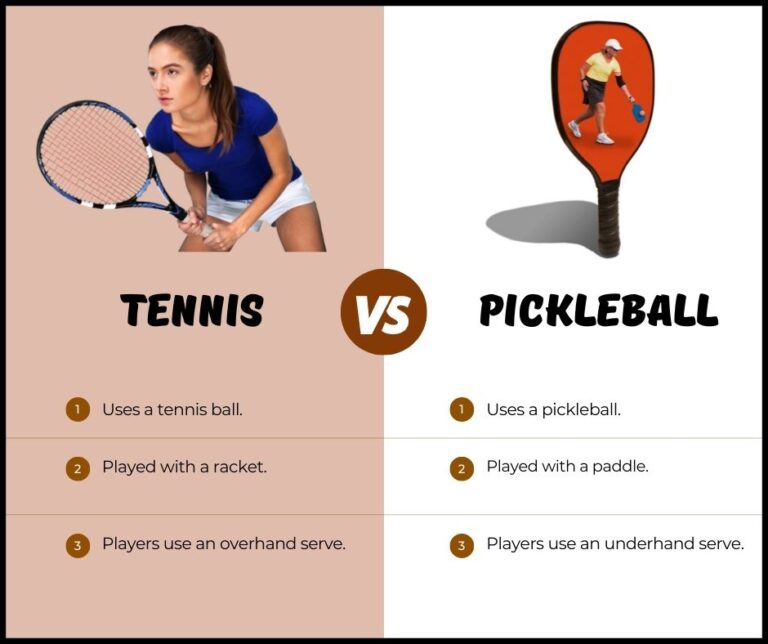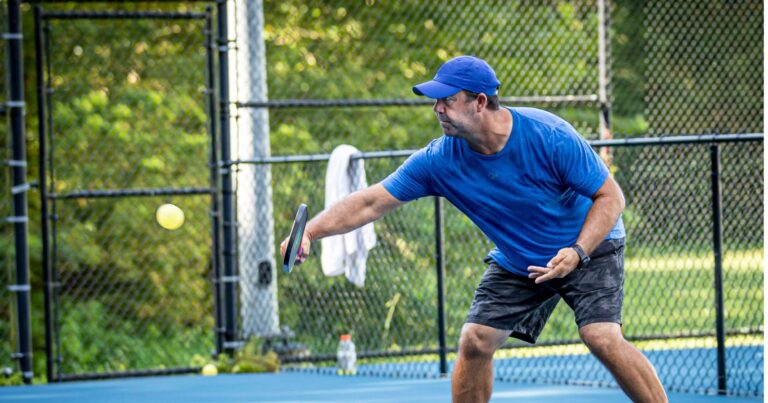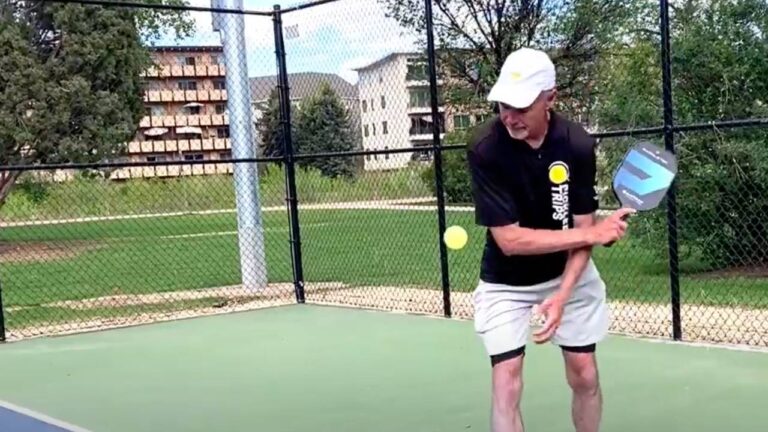How to Hold a Pickleball Paddle: Master Your Grip for Optimal Performance
How to Hold a Pickleball Paddle: Master the Grip for Powerful Shots
When holding a pickleball paddle, start with a continental grip, which is similar to shaking hands with the paddle, providing a balanced foundation for various shots. Adjust your grip pressure to maintain control without excess tension, and position your hand evenly on the handle for stability. Experiment with slight variations like the eastern or western grips to find what feels most comfortable and suits your playing style. With practice and fine-tuning, you’ll develop a confident, consistent grip that enhances your overall pickleball performance.
Key Takeaways
- A proper pickleball paddle grip is essential for control, power, and injury prevention
- There are three main types of grips: Continental (versatile), Eastern (forehand-oriented), and Western (power-focused)
- Choose a grip that suits your hand size, comfort, playing style, and paddle handle
- Follow the step-by-step guide to find and refine your ideal grip
- Avoid common mistakes like gripping too tightly, too loosely, or unevenly
- Incorporate drills and exercises to strengthen your grip and improve consistency
- Experiment with different grips, make adjustments as needed, and seek coaching guidance for personalized feedback
- Practice regularly, warm up properly, and replace your grip when it becomes worn or uncomfortable
- Mastering how to hold a pickleball paddle is a critical step in elevating your game and unlocking your full potential on the court
Are you ready to take your pickleball game to the next level? One of the most crucial aspects of playing well is knowing how to hold a pickleball paddle correctly. Your grip is the foundation of your shots, and mastering it can make a world of difference in your performance on the court.
Here’s a quick checklist to help you practice and improve your pickleball paddle grip:
- [ ] Incorporate grip strength exercises into your routine
- [ ] Practice shadow swinging drills regularly
- [ ] Participate in partner feed drills to work on consistency
- [ ] Dedicate time to practicing your grip
- [ ] Always warm up before playing or practicing
- [ ] Consider seeking guidance from a pickleball coach
At Pickleball Toolbox, we understand the importance of a proper paddle grip. That’s why we’ve put together this comprehensive guide to help you understand the different types of grips, how to choose the right one for your playing style, and tips for perfecting your hold. By the end of this article, you’ll be well on your way to unleashing more powerful and precise shots in your next game.
Why Does Grip Matter in Pickleball?
Before we dive into the specifics of how to hold a pickleball paddle, let’s take a moment to understand why your grip is so important. Here are three key reasons:
- Improved Control: A proper grip allows you to have better control over your paddle, which translates to more accurate and consistent shots. When you hold the paddle correctly, you’ll be able to manipulate the angle and direction of your shots with greater precision.
- Enhanced Power: A secure grip enables you to transfer power from your body to the paddle more efficiently. This means you can generate more force behind your shots without exerting extra effort. A good grip will help you hit the ball with more authority and keep your opponents on their toes.
- Reduced Risk of Injury: Holding your paddle with a relaxed yet firm grip can minimize the strain on your wrist and forearm. An improper grip can lead to unnecessary tension and increase your risk of developing conditions like tennis elbow. By adopting a correct grip, you’ll be able to play longer and more comfortably.
Now that we understand the significance of a proper grip let’s explore the three main types of pickleball grips.
Types of Pickleball Paddle Grips
When it comes to how to hold a pickleball paddle, there are three primary grip types: Continental, Eastern, and Western. Each grip has its own unique characteristics and benefits. Let’s take a closer look at each one.
| Grip Type | Description | Benefits | Drawbacks |
|---|---|---|---|
| Continental | “Shake hands” grip; thumb and index finger form a “V” | Versatile; good for both forehands and backhands | May limit power generation |
| Eastern | Slight rotation from Continental; “V” points to forehand | More power on forehands; popular among offensive players | Backhand shots may require more wrist manipulation |
| Western | Significant rotation from Continental; very open face | Maximum power on forehands; great for topspin and aggression | Backhand shots become very challenging; less versatile |
1. The Continental Grip (The All-Rounder)
The Continental grip, also known as the “shake hands” grip, is the most versatile and popular among pickleball players. Here’s how to execute it:
- Description: Imagine shaking hands with your paddle. Place your hand on the handle as if you’re giving it a firm handshake. Your thumb and index finger should form a “V” shape that points towards your body.
- Benefits: The Continental grip offers excellent control for both forehand and backhand strokes. It allows for quick transitions between shots and is ideal for beginners who are still developing their technique.
- Drawbacks: While the Continental grip provides a good balance of control and power, some players may find that it limits their ability to generate maximum power on their shots.
2. The Eastern Grip (The Forehand Favorite)
The Eastern grip is a slight variation of the Continental grip and is popular among players who prioritize their forehand shots. Here’s how to execute it:
- Description: Start with a Continental grip, then rotate your hand slightly clockwise (for right-handed players) or counterclockwise (for left-handed players). The “V” shape between your thumb and index finger should now point slightly towards your forehand side.
- Benefits: The Eastern grip allows for more power on your forehand shots due to the slightly open face angle of the paddle. It’s a great choice for players who like to dominate with their forehand.
- Drawbacks: Because of the adjusted hand position, hitting backhand shots with an Eastern grip may require a bit more wrist manipulation. Some players find this less comfortable or consistent.
3. The Western Grip (The Powerhouse)
The Western grip is the most extreme of the three and is favored by players who rely heavily on their forehand power. Here’s how to execute it:
- Description: From the Continental grip, rotate your hand significantly clockwise (for right-handed players) or counterclockwise (for left-handed players). The “V” shape should now point more towards your forehand side, and the paddle face will be very open.
- Benefits: The Western grip allows for maximum power on your forehand shots. The open face angle can help you generate a lot of topspin and hit aggressive, attacking shots.
- Drawbacks: The downside of the Western grip is that it makes hitting backhand shots very challenging. Players often have to switch hands or use an unorthodox backhand technique, which can be less reliable and more time-consuming.
Factors to Consider When Choosing a Pickleball Paddle Grip
Now that you’re familiar with the three main types of pickleball grips, how do you choose the right one for you? Here are some factors to consider:
- Hand size and comfort: The size of your hand and the comfort of the grip should be your top priority. If a grip feels awkward or causes strain, it’s not the right choice for you. Experiment with different grips to find the one that feels most natural and comfortable.
- Playing style: Your playing style can also influence your grip choice. If you’re a defensive player who prioritizes control and consistency, the Continental grip might be your best bet. If you’re an offensive player who loves to hit powerful forehands, the Eastern or Western grip could be a good fit.
- Paddle handle shape and size: The shape and size of your paddle handle can affect your grip choice. Some paddles have a larger or more rectangular handle, which may be more suited to certain grips. Be sure to choose a paddle that complements your preferred grip style.
Ultimately, finding your perfect grip is a personal process. Don’t be afraid to experiment with different grips and see which one feels most comfortable and allows you to execute your shots effectively. Remember, your grip may evolve as your skills develop, so be open to making adjustments along the way. Want to know paddles pro use ?

Step-by-Step Guide: How to Hold a Pickleball Paddle
Now that you know the different types of grips and what to consider when choosing one, let’s walk through the steps of how to hold a pickleball paddle.
- Determine your dominant hand: Start by identifying which hand you’ll be using to hold the paddle. Most people use their dominant hand, but some players prefer to use their non-dominant hand for added control.
- Choose your preferred grip type: Based on the factors we discussed earlier, decide which grip type you want to use (Continental, Eastern, or Western).
- Place your hand on the paddle handle: Using your chosen grip type, place your hand on the paddle handle. Make sure your hand is positioned comfortably and securely.
- Adjust your grip pressure: Find the right balance of grip pressure. You want to hold the paddle firmly enough to maintain control, but not so tightly that it causes tension or restricts your motion. A good rule of thumb is to grip the paddle with the same pressure you’d use to hold a bird without crushing it.
- Practice and refine your grip: Once you have your grip in place, practice swinging the paddle and hitting some shots. Pay attention to how the grip feels and make any necessary adjustments. It may take some time to get used to a new grip, so be patient and keep practicing.
Here’s a quick summary of the steps:
- Determine your dominant hand
- Choose your preferred grip type
- Place your hand on the paddle handle
- Adjust your grip pressure
- Practice and refine your grip
Common Mistakes to Avoid When Holding a Pickleball Paddle (And How to Fix Them)
Even with the best intentions, many players make common mistakes when gripping their pickleball paddle. Here are a few to watch out for and how to correct them:
- Gripping the paddle too tightly: Holding your paddle with a death grip can lead to tension, fatigue, and limited mobility. To fix this, try to relax your hand and loosen your grip slightly. Remember, you want to maintain control without sacrificing flexibility.
- Holding the paddle too far from the base of the handle: Gripping the paddle too far up the handle can reduce your control and power. Make sure you’re holding the paddle close to the base of the handle for optimal performance.
- Inconsistent grip pressure during shots: Varying your grip pressure during shots can lead to inconsistency and unforced errors. To fix this, focus on maintaining a consistent grip pressure throughout your swing. Practice hitting shots with a steady, controlled grip to build muscle memory.
- Gripping too loosely: On the flip side, holding your paddle too loosely can also be problematic. If you find that the paddle is slipping or twisting in your hand, try tightening your grip slightly until you feel secure and in control.
- An uneven grip: If your hand is positioned unevenly on the paddle handle, it can throw off your balance and stroke mechanics. Make sure your hand is centered on the handle and your fingers are evenly distributed for a balanced grip.
By being aware of these common mistakes and actively working to correct them, you’ll be well on your way to developing a solid and reliable pickleball grip.
Drills and Exercises to Improve Your Pickleball Paddle Grip
Improving your pickleball grip is an ongoing process that requires practice and repetition. Here are some drills and exercises you can do to strengthen your grip and improve your overall performance:
- Grip strength exercises: Building grip strength can help you maintain a secure hold on your paddle. Try using a hand gripper or squeezing a stress ball to improve your hand and forearm strength.
- Shadow swinging drills: Practice your swings without a ball to focus solely on your grip and technique. Stand in front of a mirror and take slow, deliberate swings, paying attention to your grip position and pressure.
- Partner feed drills: Have a partner toss balls to you from various angles and distances. Focus on maintaining a consistent grip throughout each shot, and make adjustments as needed.
In addition to these drills, here are a few pro tips for mastering how to hold a pickleball paddle:
- Practice makes perfect: The more you practice your grip, the more natural and comfortable it will feel. Set aside time to work on your grip consistently, even if it’s just for a few minutes each day.
- Warm-up properly: Before you start playing or practicing, take a few minutes to warm up your hands and wrists. Loose, flexible muscles will allow for a more natural and comfortable grip.
- Seek coaching guidance: If you’re unsure about your grip or want to take your technique to the next level, consider working with a qualified pickleball coach. They can provide personalized feedback and help you refine your grip for optimal performance.
Frequently Asked Questions About Pickleball Paddle Grip
- Can I change my grip during a game?
While it’s not against the rules to change your grip during a game, it’s generally not recommended. Switching grips can disrupt your rhythm and consistency. It’s best to choose a grip that works well for you and stick with it throughout the game. - Should I use an overgrip or replacement grip?
Using an overgrip or replacement grip is a matter of personal preference. Overgrips can provide added comfort and absorb sweat, while replacement grips can offer a fresh, tacky feel. Experiment with different options to see what works best for you. - How often should I replace my paddle grip?
How often you replace your grip depends on how frequently you play and how quickly the grip wears down. As a general rule, if you notice your grip becoming slippery, worn, or uncomfortable, it’s time for a replacement. Most players replace their grips every few months to maintain optimal performance.
Conclusion
Mastering how to hold a pickleball paddle is a critical step in elevating your game. By understanding the different types of grips, choosing the one that suits your playing style, and consistently practicing proper technique, you’ll be well on your way to hitting more powerful, precise, and confident shots.
Remember, the key to success is finding a grip that feels comfortable and natural for you. Don’t be afraid to experiment with different options and make adjustments as needed. With time and practice, your grip will become second nature, and you’ll be able to focus more on strategy and enjoying the game.
At Pickleball Toolbox, we’re passionate about helping players of all levels improve their skills and reach their full potential. We hope this comprehensive guide on how to hold a pickleball paddle has provided you with valuable insights and practical tips to take your game to new heights.
So, grab your paddle, get out on the court, and start perfecting your grip today! With dedication and practice, you’ll be amazed at how much your game can improve. Remember, a strong grip is the foundation of a powerful pickleball game. Master your grip, and you’ll be well on your way to pickleball success. Discover Places to play Pickleball Today !

